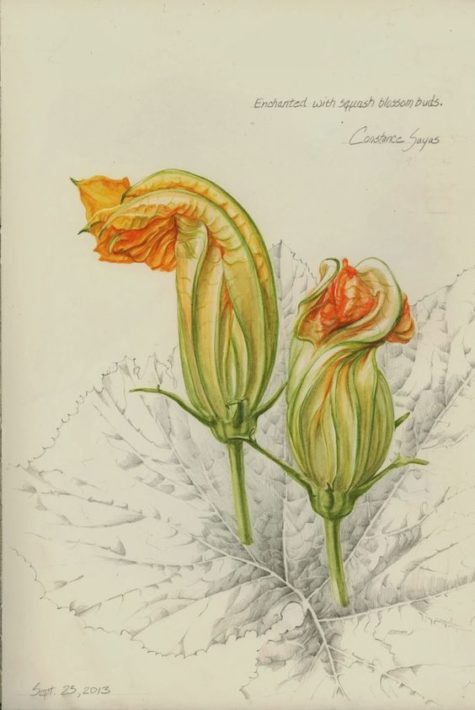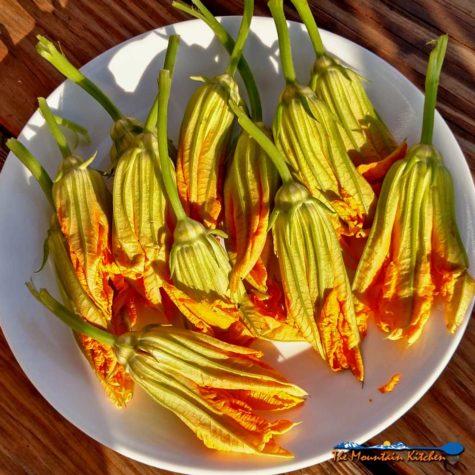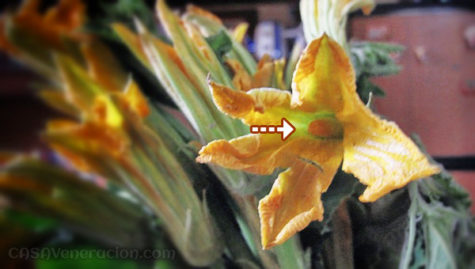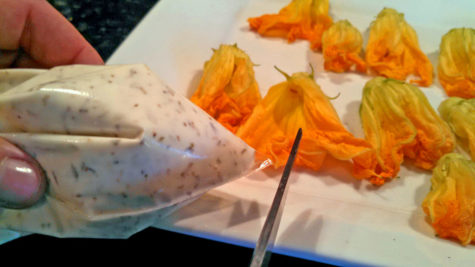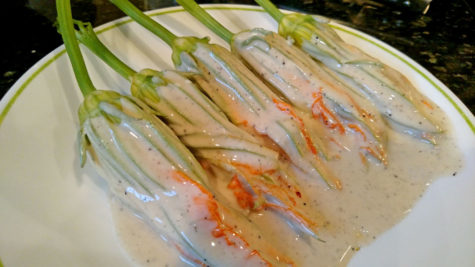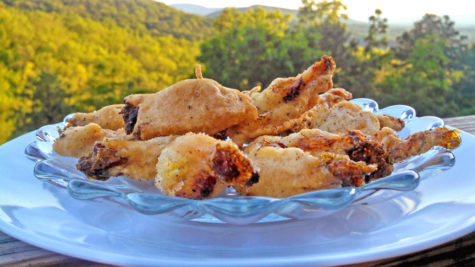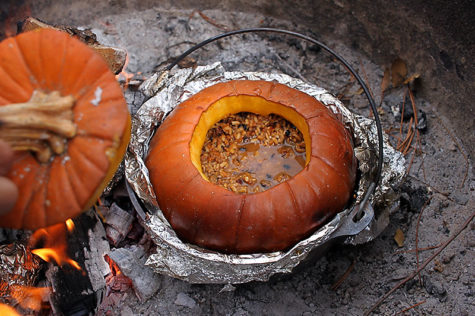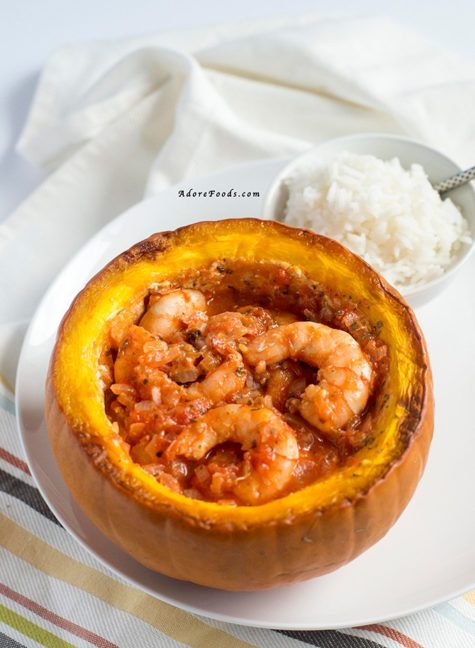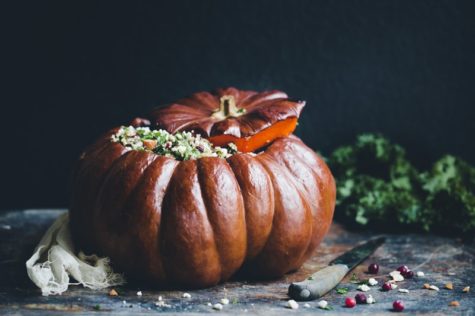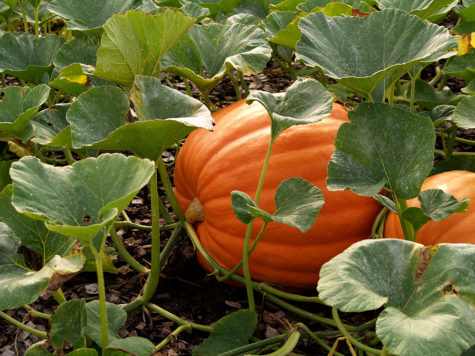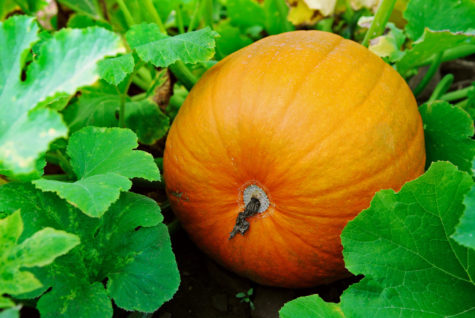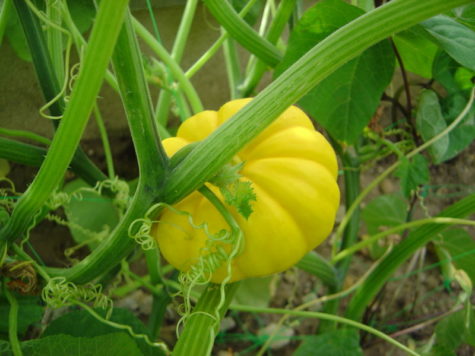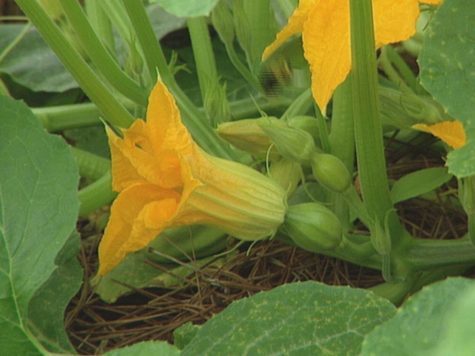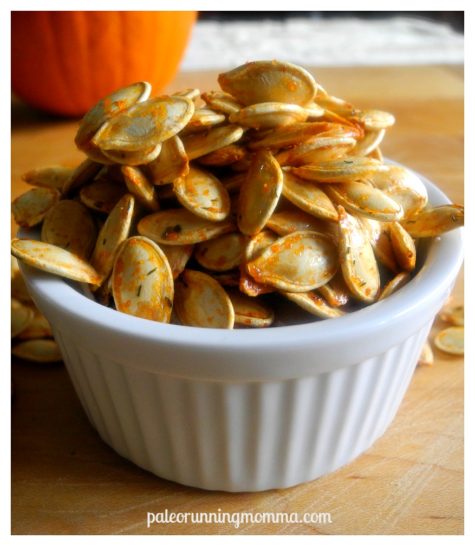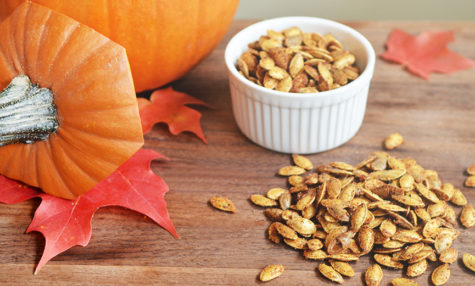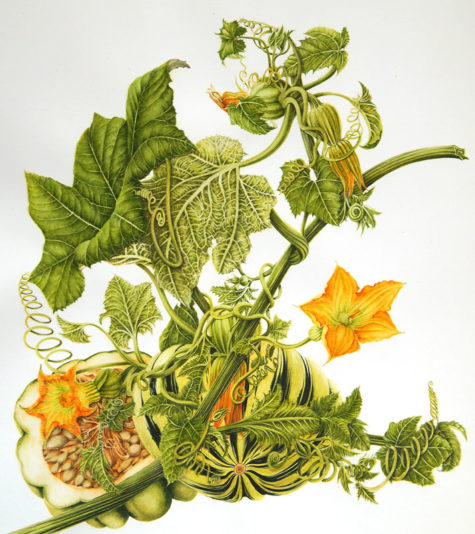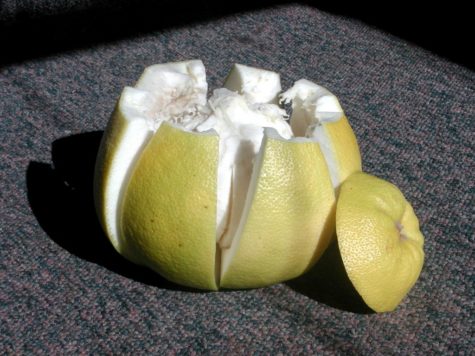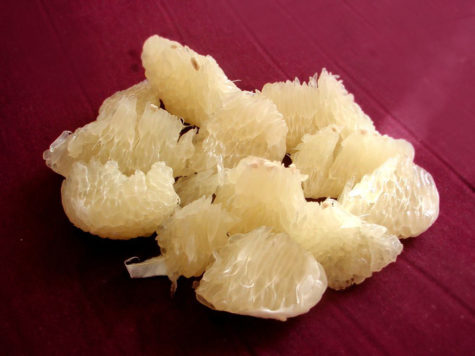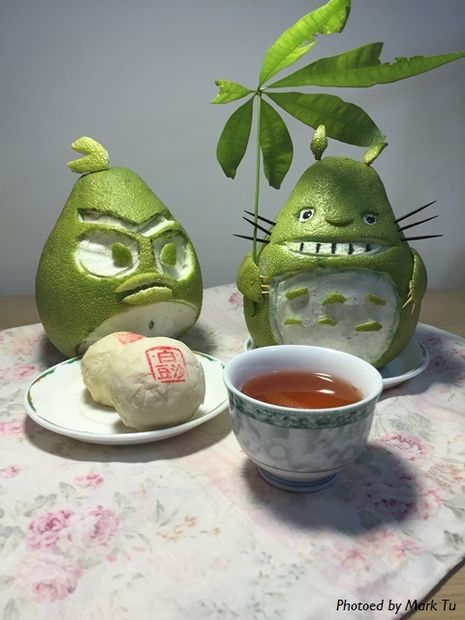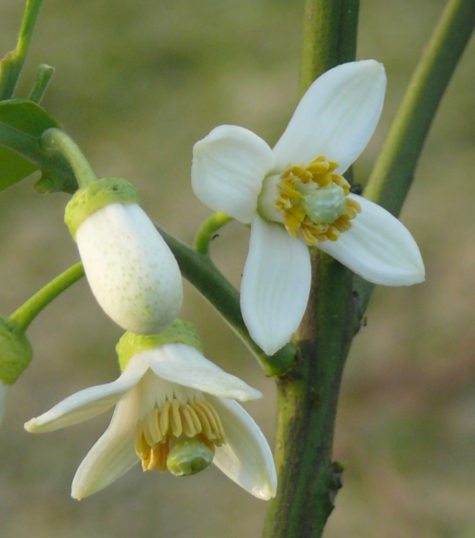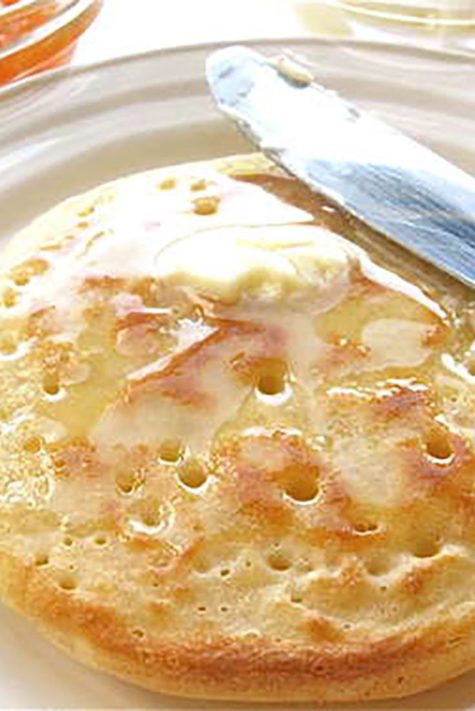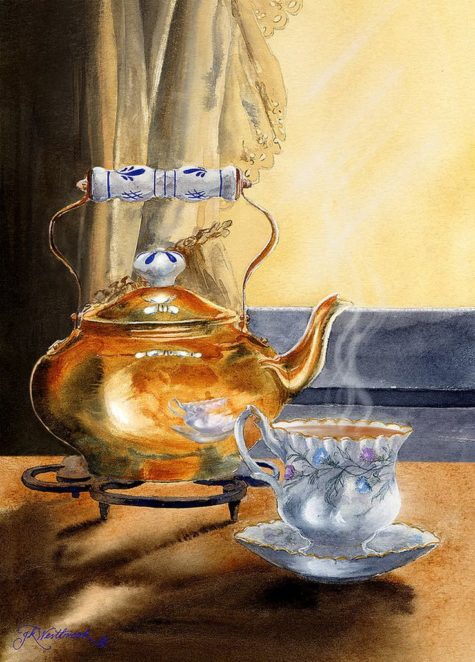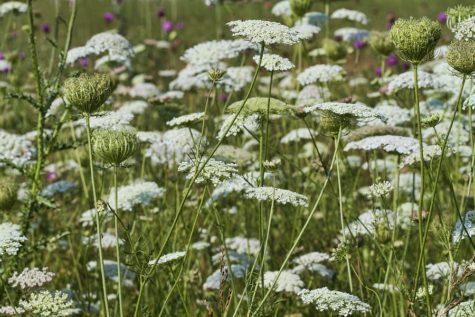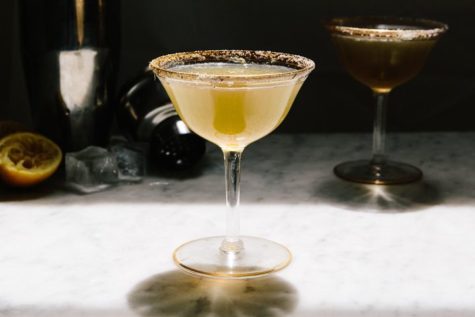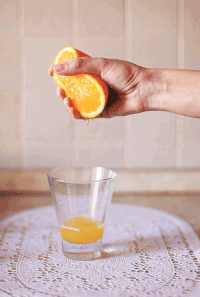Fried Squash Blossoms Stuffed With Cheese
Before I share this recipe with you, I want to help you select the blooms.
Use the blossoms from zucchini, or pumpkin. Other squash flowers may have strong, unpleasant flavors. Harvest the male flowers once they have just opened. The male flowers have stems and you can tell them from females, because the females are attached to the squash. They also go on to say that you should use them as soon as possible, but I have found that the blossoms are not as delicate as they seem. In fact, I have actually left them inside and uncovered carton in the refrigerator a couple of days and still find them easy to work with if not better.
Don’t worry, if you don’t have the luxury of growing your own squash, and you can’t find them, ask one of the farmers for flowers at your local farmers’ market or in specialty food stores. If they have zucchini on their farm stand, they’ll have blooms on their farm. I just so happen to know that farmers don’t bite and they will be happy to help you get some blossoms. Just ask!
Fried squash blossoms are practically a delicacy! The delicate squash blossoms are filled with a well seasoned creamy ricotta cheese, dipped in a light batter and fried to a crispy golden brown. If you have your own garden and zucchini are starting to run out of your ears this summer, here’s something different you can try. Prepare them as unique appetizer or as a side dish this summer for family and friends.
Here’s how you make them:
These delicate fried squash blossoms are filled with a creamy ricotta cheese mixture and dipped in a light batter, fried to a golden brown. They’re amazing! |
Ingredients:
- ¾ cup cornstarch
- 1 teaspoon baking powder
- ¼ teaspoon fresh cracked black pepper
- ¼ cup all-purpose flour
- ½ teaspoon season salt
- ½ cup water
- 1 egg, slightly beaten
- 10 to 15 squash blossoms
- ½ cup ricotta cheese
- ¼ cup mayonnaise
- 1 teaspoon dried oregano
- ½ teaspoon garlic powder
- 1 tablespoon bread crumbs
- peanut, canola or vegetable oil, for frying
- Kosher salt and fresh cracked black pepper, to taste
The batter:
Combine cornstarch, baking powder, pepper, flour, then season with salt. Stir in the egg and water until smooth. Store in the refrigerator for 15 to 20 minutes before frying.
The blossoms:
While the batter is chilling, prepare the squash blossoms.
Use your fingers to carefully separate the flower petals without breaking them and remove the pistil in the center. Rinse the flowers under cold water, paying attention not to damage petals. Lay them spaced out on a paper towel and gently pat dry.
The cheese:
Combine the cheese, mayonnaise, oregano, and breadcrumbs until smooth.
Pour the filling inside a piping bag or use a plastic storage bag and cut the tip off one corner, so that you can carefully add about a tablespoon of this mixture to each blossom and twist the top of the flower tight.
Frying them up:
Heat enough oil in a frying pan to accommodate the blossoms (about 1 inch deep). Get the batter out of the fridge and dip each blossom in batter, coating it.
When the oil is hot, carefully place each batter-covered blossom in the hot oil and fry until golden crisp on both sides.
- Be careful! This batter contains a little water, which tends to make it pop and spatter a little more than usual.
Remove the blossoms and drain on paper towels; sprinkle with salt and pepper, while hot.
Allow to cool for about 5 minutes. Serve warm. Makes: 15.
From: The Mountain Kitchen
Campfire Roasted Pumpkin Rice
- 9 inch sugar pumpkin (with a nice big stem)
- 2 cups arborio rice
- 4 – 4 ½ cups vegetable broth
- ½ tsp salt, plus more to taste
- 2 tablespoons butter
- ½ cup dried apricots, chopped
- ½ cup walnuts, chopped
- ½ cup dried barberries (see note below)
Tools needed:
- Campfire
- Foil
- Medium pot
- 10 inch / 4 quart Dutch Oven
- 10 inch Cast Iron Skillet
- Lid lifter
Do At Home:
Make sure the pumpkin fits in your dutch oven! It should sit comfortably inside the dutch oven diameter-wise. Soak barberries in warm water for 10 minutes and then drain.
Melt butter in a skillet set over medium heat. Add the dried apricots, walnuts and barberries. Cook until the fruit is softened, stirring often, about 5 minutes. Remove from heat and set aside.
In a pot, bring 4 cups of broth to a boil and add the arborio rice with ½ teaspoon of salt. Simmer with lid slightly ajar until rice is cooked, approximately 20 minutes. Check rice after about 10 minutes and make sure there is still some liquid. Add ¼ to ½ cup of water or broth if necessary.
Add nut and fruit mixture to rice and mix well. Add salt to taste if mixture still needs seasoning. Pack in water tight container or gallon sized zip top bag and store in cooler.
Do at campsite:
Get a nice campfire going to build a bed of hot coals.
Wash and dry pumpkin. Cut a lid around the stem and set aside. Scrape out insides of pumpkin leaving only the firm flesh.
Set the pumpkin in the dutch oven and scoop the rice filling into it. Don’t over fill the pumpkin – the pumpkin lid should still close tightly.
To cover the pumpkin and create an oven-like condition, use a 10 inch cast iron skillet as an improvised lid by turning it upside down and placing over the dutch oven. If the pumpkin is too tall, get creative and build a foil cover that will be easy to open/remove and put back on (you’ll need to check in on the pumpkin during the process).
Set the dutch oven directly in the fire pit with coals using your lid lifter. Place hot coals on top of the cast iron lid. Rotate ¼ turn every 15 minutes until pumpkin outside is slightly soft to the touch and the inside flesh is soft.
Remove from the campfire and set on heat-proof surface. Using a big spoon, scoop up rice, scraping up bits of pumpkin at the same time. Serve immediately.
- Note: Barberries have a unique tart-like flavor and are commonly found at Middle Eastern grocers. If you can’t find them, substitute currants soaked in lemon juice.
Makes: 8 servings
From: The Dirty Gourmet
Brazilian Shrimp Stuffed Pumpkin
Camarao na Moranga
Ingredients:
- 1 medium pumpkin
- 4 tablespoons olive oil, divided
- 1 pound wild caught large shrimp (prawn), cleaned and deveined
- 1 medium onion, finely chopped
- 1 jalapeño pepper, chopped
- 2 garlic cloves, minced
- 4 large ripe tomatoes, chopped
- ¼ cup fresh cilantro, finely chopped
- 1 cup cream cheese
- salt and pepper
Instructions:
Preheat oven to 350F/ 180C.
Wash the pumpkin and cut off the top. Scoop out the flesh and remove all seeds. Wrap it in aluminum foil and place it onto a baking tray, cut-off side down. Bake for about 40-50 minutes, until it is nearly soft. Remove it from the oven and unwrap from aluminium foil. Set aside.
In a large pan, heat olive oil on medium heat. Sauté the onion for 2-3 minutes, until golden. Add garlic, chopped jalapeño and cook for 3-4 minutes. Add shrimp to the pan and continue cooking for another minute. Add chopped fresh tomatoes, season with salt and pepper. Cook, stirring occasionally, until tomatoes are soft, for approximately 5 minutes. Remove from heat and add fresh cilantro. Set aside.
Using a spoon, spread the cream cheese inside the pumpkin, trying to coat all the inside area. Pour shrimp stew into the pumpkin and return to the oven. Bake for another 20 minutes, or until cheese melts and pumpkin becomes really soft inside. Remove from oven, sprinkle some more fresh cilantro on top. Serve warm with white rice on the side.
Makes: 4 servings
Source: Adore Foods
All Saints’ Day Pumpkin
Calabaza de Todos Los Santos
In the Basque countries, Spanish and French, the pumpkin is also associated with the supernatural feeling of the Halloween season. This dish is traditionally found on November the 1st in many peasant homes.
Ingredients:
- 1 large pumpkin
- 1 lb rice, uncooked
- 2 cloves garlic
- 1 large green pepper
- 2 lbs medium shrimps, sautéed in butter
- 1 tbsp grated onion
- 2 tbsp butter
- salt and pepper to taste
Clean and de-vein shrimps, chop green pepper and garlic. Sauté in 1 tablespoon butter and add onion. Cut the top from pumpkin, remove all the seeds.
- Note: Save the top to use as a lid.
Place rice in pumpkin, put the rest of the ingredients on top of the rice, and sprinkle with salt and pepper. Attach the lid with toothpicks. Place pumpkin on baking tray and bake in a 325 oven for 1 – 2 1/2 hours. To serve, remove the lid and scoop out the pumpkin / rice / shrimp mixture. Serves 6 to 8.
From: Authentic Spanish Cooking
Pumpkin
If you want to look and feel beautiful, consider including pumpkin as part of your diet.
Pumpkin has a range of fantastic health benefits, including being one of the best-known sources of beta-carotene. Beta-carotene is a powerful antioxidant. It also gives orange vegetables and fruits their vibrant color. The body converts any ingested beta-carotene into vitamin A.
Beta-carotene is a powerful antioxidant. It also gives orange vegetables and fruits their vibrant color. The body converts any ingested beta-carotene into vitamin A. Consuming foods rich in beta-carotene may reduce the risk of developing certain types of cancer, offer protection against asthma and heart disease, and delay aging and body degeneration. Pumpkins are also a powerful source of fiber.
The potassium contained within pumpkins can have a positive effect on blood pressure. The antioxidants in pumpkin could help prevent degenerative damage to the eyes.
Many studies have suggested that eating more plant foods such as pumpkin decreases the risk of obesity and overall mortality. It can also help prevent diabetes and heart disease, and promote a healthy complexion and hair, increased energy, and a healthful body mass index (BMI).
Pumpkin has been implicated in helping with the following:
- Aids in weight loss (due to fiber content)
- May reduce cancer risk (due to the antioxidant beta-carotene)
- Protects the skin (due to carotenoids)
- Sharpens eyesight (due to high levels of vitamin A)
- Maintains prostate health (due to zinc content of seeds)
- Helps boost mood and prevent depression (due to tryptophan content in seeds)
- Improves heart and muscle function (due to potassium and magnesium content)
- Improves immune system (due to zinc and vitamin C content)
- Helps expel intestinal worms (due to cucurbitins)
More on this “super” food can be found here: Encyclopedia of Herbology: Pumpkin
Pumpkin – It’s What’s For Dinner:
The edible parts of a pumpkin are the leaves, fruit and the seeds. High nutrients and medicinal properties in pumpkin leaves, fruit and seeds make it an attractive health food proposition.
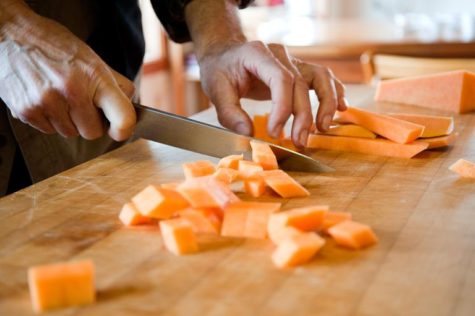
The pumpkin’s flesh can be either sweet or bitter, and it is commonly used in pies, scones, soups, stews, and other recipes.
- Pumpkins are high in protein and fiber, but low in fat. They are an excellent source of iron and vitamin A.
- Cooked pumpkin provides about 20 calories and 4.90 g of carbohydrates per 100 g serving.
The young fruit of a pumpkin is best used in savory entrees and sides, while the mature fruit goes best in pies and other sweet desserts. Medium-sized varieties, like ‘Autumn Gold’, ‘Jack-o-Lantern’, and ‘Spirit’ are among the best for culinary use; however, larger varieties like ‘Big Tom’ and ‘Jackpot’ are also popular.
When ripe, the pumpkin can be boiled, steamed, or roasted. Pumpkins that are still small and green may be eaten in the same way as pumpkin or zucchini.
In addition the fruit can be baked by cutting it into two halves, scooping out seeds and placing the hollow side down in a big tray followed by baking in an oven.
Preparing fresh pumpkin at home will deliver the most benefits for your health, but canned pumpkin is also a great choice. Pumpkin retains many of its health benefits in the canning process.
Pumpkin pie is a sweeter way to incorporate the benefits of pumpkin into the diet. Be sure to make a pumpkin puree rather than buying pre-made. Steer clear of canned pumpkin pie mix. This is usually placed next to the canned pumpkin in grocery stores, and is sold in a similar can. It contains added sugars and syrups.
- Canned pumpkin should have only one ingredient: Pumpkin.
Pumpkin is a highly nutrient-dense food. It is rich in vitamins and minerals but low in calories. Pumpkin seeds, leaves, and juices all pack a powerful nutritional punch. Although the variety of pumpkins that usually ends up carved into a jack-o-lantern is perfectly edible, it is best to cook with the sweeter and smaller sweet or pie pumpkin varieties.
Make sure the pumpkin has a few inches of stem left and is hard and heavy for its size. Store uncut pumpkins in a cool, dark place for up to 2 months.
The most common preparation methods of pumpkin involve desserts like custards and pies. One of the simplest ways to enjoy the contents is to gently roast or dehydrate the seeds in sea salt and other preferred spices.
There are many ways pumpkin can be incorporated into desserts, soups, salads, preserves, and even as a substitute for butter.
- Use pumpkin puree or canned pumpkin in place of oil or butter in any baking recipe.
- Make a quick treat of pumpkin chocolate yogurt by combining Greek yogurt, pumpkin puree or canned pumpkin, honey, cinnamon, and cocoa powder.
Harvesting and Preparing the Flowers
Pumpkin flower blossoms have a light, buttery taste. They are sometimes prepared as vegetables in a number of pasta, soup, and salad recipes.
The female blossoms will become the fruit so in order to preserve your harvest, it is best to pick the male blooms. Being aware of the difference between male and female blooms is important to know when picking pumpkin blossoms.
Male pumpkin blossoms are hairier and have a thin base where they attach to the stem. Females have a thick bulge, which is the ovary, where they grow from the plant.
Morning is the best time for harvesting pumpkin flowers. Choose male flowers when they are still in bud form. Male flowers grow first on the plant but the fully formed blooms are hairy and difficult to handle in the kitchen. Female blooms are considered the tastiest but you should minimize their harvest if you want fruit on the plant.
Give a gentle squeeze to the back of the bloom when picking pumpkin flowers. This will help you detect the bulb of a female or the flat end of a male flower.
- How to Store Pumpkin Blossoms:
The optimum condition is to use them the day of harvest. Picking pumpkin flowers and then using them immediately gives you the freshest taste of spring. Pumpkin flowers are very delicate and don’t store for long. However, there is a trick on how to store pumpkin blossoms for best flavor and to extend the life of the blooms. Keep them in the refrigerator. Male blooms last the longest and can be stored in the refrigerator for up to a week. Either sex will keep best if laid out gently on tissue or a paper towel on a dish or flat container.
- How To Prepare Pumpkin Blossoms:
Pumpkin fresh flowers add flavor to salads. Eaten as a side dish, the recipe is as follows: Pick flowers when vines are blooming, wash and roll in paper towel to dry. Dip in beaten egg, roll in fine bread or cracker crumbs and fry in buttered pan.
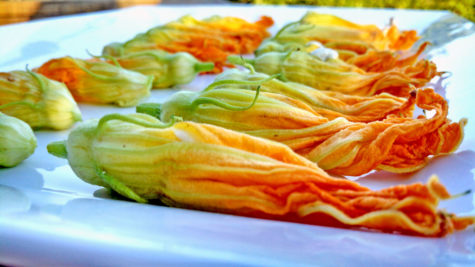
In the southwestern United States and Mexico, pumpkin and pumpkin flowers are a popular and widely available food item. They may be used to garnish dishes, and they may be dredged in a batter then fried in oil.
Pumpkin blossoms are flavorful and colorful when used as a garnish on salads. Remove the anthers inside, wash, dry the flowers, and use them whole or chopped. Stuff the blooms with rice, herbs or cheese when cooking with pumpkin flowers. You can also pickle, deep fry, or can pumpkin blossoms. If you cook the flowers, you can freeze them.
The flowers can be eaten straight off of the plant, added them into a salad, and for a nice breakfast treat, they can be dipped into pancake batter, cooked in a skillet.
Whichever method you choose, prepare the blooms as quickly as possible for best flavor and texture. Harvesting pumpkin flowers is easy and a great way to put the male blooms to use rather than having them simply fall from the plant to waste away.
Harvesting and Preparing the Leaves
Pumpkin leaves are edible. They are chock-full of iron, and may be prepared like other dark green, leafy vegetables. How do they taste? Here’s a review:
“The pumpkin greens lacked any bitterness that other greens tend to have, which surprised me. These might be the sweetest greens I have eaten. Even my son and wife enjoyed them. The flavor reminded me of a mixture of green beans, broccoli, spinach and asparagus.”
Italian pasta recipes include the leaves and stems, blanched briefly, then fried with oil and garlic before being tossed with chopped tomatoes. The Malaysian dish Pucuk Labu combines smaller, tender pumpkin leaves and shoots with anchovies, garlic and sliced onions, all simmered in rich coconut milk.
Pick the young-medium aged leaves (not the older tougher ones), and use them in cooked recipes like you would a spinach or a heavy winter green.
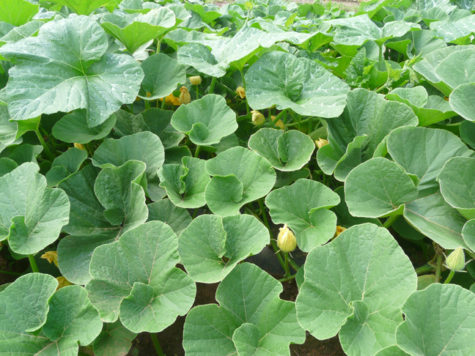
Covered in fuzz and possessing a thick, fibrous spine, pumpkin leaves aren’t all that intuitively edible. They take a little bit of advance preparation before you can use them in recipes.
Here is a simple method:
“Holding the leaf upside down by its stem, you see that the stem is hollow. Use your thumbnail to split half or a third of the stem and snap it backward so that the flesh breaks cleanly, but the outer fibers do not. Pull gently, removing the fibers from the outside of the stem and the back of the leaf. Repeat until you have de-strung a good pile, because, like all greens, pumpkin leaves cook down quite a bit.”
Once you’ve de-strung a pile of pumpkin leaves, you can cook them in a variety of ways. In Malawi, they are often simmered simply with tomatoes just for a few minutes until the leaves are tender.
Harvesting and Preparing the Seeds
Pumpkin seeds are a good source of plant protein, high mineral content, and vitamin F.
Traditional folk medicine touts pumpkin seeds as an effective treatment for prostate enlargement. Anti-inflammatory agents, known as phytosterols, combine with the healing properties of zinc to potentially reduce the size of the prostate.
Pumpkin seeds are just about the richest natural sources of zinc nutrition ever found. The use of pumpkin seeds for their beneficial effect on the prostate gland is as old as the ages. (Referred to as He-man power).
Pumpkin seeds are usually roasted and consumed as healthy, protein-packed snacks.
To harvest your pumpkin seeds, slice open your pumpkin (to eat or to make as a jack-o-lantern). Scoop out the seeds with your hands or a large, sturdy spoon. Place the seeds in a bowl. *Some pumpkin varieties have seeds with white husks over the nut meat, and some just contain the green nutmeat, aka “pepitos.”
You can process and eat pumpkin seeds the same way, regardless of the variety.
Heat a frying pan and add enough high heat vegetable oil (we like organic sunflower, grapeseed, or raw coconut oil) to sauté them. Once the pan is hot, add the pumpkin seeds. *Don’t worry if there is a little bit of pumpkin string still attached, this cooks up fine and adds some nice flavor & nutrition.
As soon as the seeds are in the pan, add some fresh ground sea salt. Stir repeatedly to ensure light, even browning uniformly on the seeds’ surfaces. Let them cool down, but eat them while they’re still warm for best flavor! They’ll also store for a long time and make a great, healthy alternative to potato chips.
Nutritional breakdown
According to the USDA National Nutrient Database, one cup of cooked, boiled, or drained pumpkin without salt contains:
- 1.76 g of protein
- 2.7 g of fiber
- 49 calories
- 0.17 g of fat
- 0 g of cholesterol
- 12.01 g of carbohydrate
This amount of pumpkin also provides:
- more than 200 % of the recommended daily allowance (RDA) of vitamin A
- 19 % of the RDA of vitamin C
- 10 % or more of the RDA of vitamin E, riboflavin, potassium, copper, and manganese
- at least 5 % of thiamin, B-6, folate, pantothenic acid, niacin, iron, magnesium, and phosphorus
In addition to the meat, one can also consume the green seeds inside their shell, which also provides a concentrated dose of nutrition, such as:
- An excellent source of vitamin K
- Rich in riboflavin, folate, thiamin, B6, and niacin
- Good source of vitamin A
- Excellent source of manganese, magnesium, phosphorus, iron, copper, zinc, and potassium
- Contains beneficial amounts of selenium
- Excellent source of healthy fats and dietary fiber
- Quality source of vegan protein (1 ounce yields 7 grams of protein)
Around The World
Pumpkin leaves are traditional vegetables of choice to many communities in Africa, North America and Asia. This is because of their ease of availability, rich in nutrients and less demanding husbandry. The leaves are normally mashed with potatoes, maize, beans and bananas to make a delicious meal.
- In Tanzania, pumpkin leaves, peanut butter, onion, chili and coconut cream are nicely blended to make a soup called ‘M’chicha Wa’nazi’.
- In Kenya, ‘Mukimo’ is a delicacy prepared by mixing well cooked maize, peeled potatoes and mashing them together with pumpkin leaves and sometimes boiled pumpkin fruit slices.
- In the Middle East, pumpkin is used for sweet dishes; a well-known sweet delicacy is called halawa yaqtin.
- In South Asian countries such as India, pumpkin is cooked with butter, sugar, and spices in a dish called kadu ka halwa.
- Pumpkin is used to make sambar in Udupi cuisine.
- In Guangxi province, China, the leaves of the pumpkin plant are consumed as a cooked vegetable or in soups.
- In Australia and New Zealand, pumpkin is often roasted in conjunction with other vegetables.
- In Japan, small pumpkins are served in savory dishes, including tempura.
- In Myanmar, pumpkins are used in both cooking and desserts (candied). The seeds are a popular sunflower seed substitute.
- In Thailand, small pumpkins are steamed with custard inside and served as a dessert.
- In Vietnam, pumpkins are commonly cooked in soups with pork or shrimp.
- In Italy, it can be used with cheeses as a savory stuffing for ravioli.
- In Nigeria, pumpkin leaves are used to make soup, cassava salad, plantain porridge and ‘Asaro or Ebe’ (yam pottage).
- Pumpkin leaves are also eaten in Zambia, where they are called chibwabwa and are boiled and cooked with groundnut paste as a side dish.
- Pumpkin leaves, usually of C. moschata varieties, are eaten as vegetable in Korean cuisine.
Borrowed from: Encyclopedia of Herbology
What is a Pomelo?
Pomelos are a must during the mid-autumn festival or mooncake festival;
they are normally eaten fresh.
The pomelo (Citrus maxima or Citrus grandis) is a citrus fruit native to South East Asia. It is usually pale green to yellow when ripe, with sweet white (or, more rarely, pink or red) flesh and very thick pudgy rind. It is the largest citrus fruit, 15–25 cm in diameter, and usually weighing 1–2 kg. Other spellings for pomelo include pummelo, and pommelo, and other names include Chinese grapefruit, jabong, lusho fruit, pompelmous, Papanas, and shaddock. Pomelos are also referred to as chakotara in Pakistan, Afghanistan and India. In the Indian State Manipur this fruit is known as Nobab.
Cultivation and uses
The pomelo tastes like a sweet, mild grapefruit, though the typical pomelo is much larger in size than the grapefruit. It has very little, or none, of the common grapefruit’s bitterness, but the enveloping membranous material around the segments is bitter, considered inedible, and thus usually discarded. The peel is sometimes used to make marmalade, or candied, then (sometimes) dipped in chocolate. The peel of the pomelo is also used in Chinese cooking. In general, citrus peel is often used in southern Chinese cuisine for flavouring, especially in sweet soup desserts.
In the Philippines, the fruit is known as the suhâ, or lukban, and is eaten as a dessert or snack. The pomelo, cut into wedges, is dipped in salt before it is eaten. Pomelo juices and pomelo-flavored juice drink mixes are also common.
In Thailand, the fruit is called som-oh (ส้มโอ), and is eaten raw, usually dipped into a salt, sugar and chili pepper mixture.
In Malaysia, Tambun town near Ipoh, Perak is famous for pomelos. There are two varieties: a sweet kind, which has white flesh, and a sour kind, which has pinkish flesh and is more likely to be used as an altar decoration than actually eaten. Pomelos are a must during the mid-autumn festival or mooncake festival; they are normally eaten fresh.
More about the festival can be found on The Pagan Calendar, here:
The tangelo is a hybrid between the pomelo and the tangerine. It has a thicker skin than a tangerine and is less sweet. It has been suggested that the orange is also a hybrid of the two fruits.
In Manipur, nobab is used as a major source of vitamin C. This fruit holds a high place in the culture and tradition of Manipur. Many religious rituals seem incomplete without this fruit.
The flowers are beautiful, aren’t they?
A Crumpet Recipe
What is a crumpet? This traditional British teatime treat is midway between English muffin and pancake. Like an English muffin, it’s full of holes, perfect for collecting rivulets of melted butter. But it’s also moister and thinner – more like a small pancake.
These are best enjoyed toasted, and spread with butter, jam, and/or clotted cream. Since their holes reach to the outside crust, there’s no need to split them before toasting.
You can make crumpets without English muffin rings (or cleaned tuna cans), but they’ll be perfectly round and ever so much nicer looking if you use rings. Here’s a recipe from King Arthur Flour.
A Great Crumpet Recipe
Ingredients:
- 1 1/2 cups lukewarm water
- 1 cup lukewarm milk
- 2 tablespoons melted butter
- 3 1/2 cups Unbleached All-Purpose Flour
- 2 1/2 teaspoons instant yeast
- 1 teaspoon baking powder
- 1 1/4 teaspoons salt
Instructions:
Combine all of the ingredients in a bowl, and beat vigorously for 2 minutes. A stand or hand mixer, set on high speed, work well here.
Cover the bowl, and let the batter rest at room temperature for 1 hour. It will expand and become bubbly. Towards the end of the rest, preheat a griddle to medium-low, about 325°F. If you don’t have an electric griddle, preheat a frying pan; it shouldn’t be as hot as the temperature you use to cook pancakes.
Lightly grease the griddle or frying pan, and place well-greased 3 3/4″ English muffin rings in the pan, as many as will fit. (If you don’t have English muffin rings, use well-cleaned tuna cans, from which you’ve removed the top and bottom.) Pour sticky batter by the scant 1/4-cupful into each ring; a muffin scoop works well here.
After about 4 minutes, use a pair of tongs to slip the rings off. Cook the crumpets for a total of about 10 minutes on the first side, until their tops are riddled with small bubbles/holes. They should be starting to look a bit dry around the edges. Their bottoms will be a mottled, light-golden brown.
Note: They probably won’t be as full of holes as store-bought crumpets; that’s OK.
Turn the crumpets over, and cook for an additional 5 minutes, to finish cooking the insides and to brown the tops gently. This isn’t traditional; “real” crumpets are white on top, but the crumpet police won’t chastise you for adding a little color to the tops.
Remove the crumpets from the pan, and repeat with the remaining batter, until all the crumpets are cooked. Serve warm. Or cool completely, wrap in plastic, and store at room temperature. To enjoy, warm in the toaster. Serve with butter, or butter and jam.
Borrowed from: The Prosperity Project
It’s Tea Time
I think it’s time for a spot of tea!
First up, let’s talk about the tea.
What’s in a tea? Well, hundreds of benefits are hidden within this coloured water that not so many people are particularly fond of. Summer is a great time to take up this wonderful habit, by creating the most appealing iced teas and thus benefiting from their medicinal and restorative powers.
What few of us know is the fact that the word “tea” is correctly used for the following types only:
- Green tea
- Black tea
- White tea
- Oolong tea
- Pu-erh tea
These 5 teas are definitely worth the try. The rest should simply be referred to as infusions. The five kinds are all derived from the Camellia sinensis plant, a shrub native to China and India, and contain unique antioxidants called flavonoids. They all protect against free radicals that can contribute to cancer, heart disease, and clogged arteries. Oolong and black teas are oxidized or fermented, so they have lower concentrations of flavonoids than green tea, but nevertheless their antioxidising power is still high.
Green tea makes you smart and slim
Green tea is supposedly the healthiest beverage on our planet. It contains more than just plain caffeine. Apart from the fact that it produces a response without causing the “jittery” effects associated with too much caffeine, it also has the amino acid L-theanine, which increases the activity of the inhibitory neurotransmitter GABA, which has anti-anxiety effects. It also increases dopamine and the production of alpha waves in the brain.
In other words, these two components mixed together are particularly capable of improving overall brain function.
Apart from making you smart, your drinking at least three cups of green tea a day is recommended to raise the body’s metabolic rate. It is believed that the catechins found in it increase the production of heat within the body, which is related to burning calories. These compounds may inhibit certain chemicals in the brain, thus prolonging this process.
Black tea makes your teeth healthy
Black tea was proved to reduce plaque formation as well as restricting bacteria growth that promotes the formation of cavities and tooth decays. The flavonoids found in black tea kill and surpass cavity bacteria as well as inhibit the growth of bacterial enzymes that form along with that sticky white stuff on our teeth that attracts plaque like a magnet.
White tea keeps your bones healthy
White tea’s antioxidants and anti-aging properties not only protect and help reverse damaged skin, but a regular intake of white tea can improve bone density and strength, and may provide a natural relief from the symptoms of osteoporosis.
Oolong tea makes your skin look healthy and young
According to the Tea Association of the United States, oolong tea falls somewhere between green and black teas, as its leaves are only partially oxidized.
Patients diagnosed with eczema are recommended to drink 3 cups of oolong tea per the day. The beneficial results of oolong tea are likely to be seen in less than a week in these patients. All oolong tea drinkers show remarkable improvement in their skin.
Keep in mind that despite its miraculous effects, oolong tea tends to be very high in caffeine, which is not the healthiest component of this beverage. So if a healthy skin is your aim, try not to exaggerate and drink more than 3 cups a day.
Pu-erh tea is the best hangover cure
In traditional Chinese herbalism, pu-erh tea is considered to open the meridians and warm the spleen and stomach. It helps digestion and cleans your blood. It is often consumed after heavy meals or drunk as a hangover cure or preventative.
The microbial aging of pu-erh tea can result in the production of lovastatin, a natural statin that is used to lower levels of bad cholesterol such as LDL. One study found that the longer this type of tea was aged, the more statin was produced.
So drink up! It is recommended to have a slightly hot cup of tea every time you feel hot, and your body’s temperature will return to its regular value.
How to make a good pot of tea
These are the golden rules:
- Tea loves oxygen – it helps the flavor develop, so always use freshly drawn cold water in the kettle.
- Make sure your pot is clean.
- Warm the pot by swirling a small amount of boiled water in it.
- For black tea, only pour on freshly boiled water and do not over-boil it.
- For green tea, always use the water just at the boil.
- One teaspoon of loose tea per person and one teaspoon for the pot is about right, but add as much or as little to make it to the strength you like.
- Some people believe that sugar masks the flavors in tea. Why not try a fruit tea if you prefer a sweeter taste?
- A tea cosy extends the brewing time and can make the tea bitter and stewed. A removable infuser or teabags can help to get round this problem.
How long should I allow a teabag to brew?
Twinings of London recommends that you allow the teabag to brew for two and a half to three minutes. This allows the flavor to fully develop. Then add milk or lemon or enjoy it black, whatever your preference.
And how long should I allow loose tea to brew?
We recommend that you allow loose tea to brew in a teapot for up to seven minutes. The general rule is: the larger the leaf, the longer the brewing time. Earl Grey and Lady Grey need five minutes, while a smaller leaf tea will only need about four minutes.
Does loose tea make better tea than teabags?
Both have their benefits. For many people, the ritual of preparing loose tea is a pleasure in itself, so this contributes to the enjoyment, while teabags are more convenient. The leaf size is different but the quality in the cup will be the same.
Should the milk go in first or second?
Historically, the ‘milk in first’ rule was to protect the fine bone china it was served in – it’s a very individual thing.
Sometimes I get an oily residue around my cup and on the surface of my tea – what is it?
Because of the small leaf-size in a teabag, the tea can release some essential oils which can sometimes produce a residue. However, this brown residue occurs most often in areas with hard water, so a carbon water filter will reduce this considerably.
How should tea be stored?
Tea absorbs moisture and kitchen smells. To keep your tea fresh and avoid spoiling the flavor, keep loose tea or teabags in a sealed jar or tin.
Borrowed from: The Prosperity Project
Queen Anne’s Lace Jelly
- 18 large Queen Anne’s lace heads
- 4 Cups water
- ¼ Cup lemon juice (fresh or bottled)
- 1 Package powdered pectin
- 3 ½ Cups + 2 Tbsp. sugar
Bring water to boil. Remove from heat. Add flower heads (push them down into the water). Cover and steep 30 minutes. Strain.
Measure 3 cups of liquid into a 4 – 6 quart pan. Add lemon juice and pectin. Bring to a rolling boil stirring constantly. Add sugar and stir constantly. Cook and stir until mixture comes to a rolling boil. Boil one minute longer, and then remove from heat.
Add color (pink) if desired. Skim. Pour into jars leaving ¼” head space. Then process in a hot water bath for 5 minutes.
Makes about 6 jars
Important Notice:
Historically, Queen Anne’s lace was used for medicinal and contraceptive purposes. Avoid it if you are pregnant, and check with your doctor if you are currently taking medications. More information about this wild herb can be found here: Encyclopedia of Herbology – Wild Carrot
The carrot family contains a number of poisonous look-alikes, most notably poison hemlock. Once the fruit has formed, it is easy to tell them apart, but less so when the plants still only have leaves.
When foraging, always choose high-quality landscapes (not next to the highway or on post-industrial or sprayed sites), and make sure to obtain permission if it is not your own yard. If possible, go out with an experienced forager.
Found at: Herbal Riot
Queen Anne’s Lace Cognac Apéritif
On late-summer evenings, I take the chill off with a cognac apéritif, the rim of the glass dipped in spicy Queen Anne’s Lace.
For the rim:
- 3 tablespoons dried Queen Anne’s Lace fruits
- 1 1/2 tablespoons fine sugar
Crush the dried Queen Anne’s Lace fruits with the sugar and mix thoroughly. (To save effort for multiple drinks, we made a larger batch with the same 2:1 ratio.) Spread the mixture on a saucer or plate that is larger than the diameter of the glass rim. Moisten the rim of the glass by dipping it upside down in a shallow bowl of water and let the excess water drip off for a few seconds. Dip the moistened rim in the Queen Anne’s Lace/sugar mixture, pressing down firmly. The mixture should cling to the rim where moistened. Gently shake off any excess.
Note: Instructions on collecting the Queen Anne’s Lace fruits can be found here: Queen Anne’s Lace
For the drink:
- 2 ounces cognac (I suggest Pierre Ferrant 1840)
- 3/4 ounce fresh Meyer lemon juice or bergamot juice
- 3/4 ounce honey syrup (equal parts honey and hot water)
- 1 teaspoon dried Queen Anne’s Lace fruit
In a cocktail shaker, combine cognac, lemon juice syrup, and ice. Shake vigorously for half a minute or until chilled. Pour the mixture through a strainer (to remove the Queen Anne’s Lace bits) and into the rimmed glass. Serve immediately.
Makes 1
Important Notice:
Historically, Queen Anne’s lace was used for medicinal and contraceptive purposes. Avoid it if you are pregnant, and check with your doctor if you are currently taking medications. More information about this wild herb can be found here: Encyclopedia of Herbology – Wild Carrot
The carrot family contains a number of poisonous look-alikes, most notably poison hemlock. Once the fruit has formed, it is easy to tell them apart, but less so when the plants still only have leaves.
When foraging, always choose high-quality landscapes (not next to the highway or on post-industrial or sprayed sites), and make sure to obtain permission if it is not your own yard. If possible, go out with an experienced forager.
Found at: Food 52
